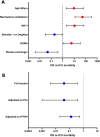Severe autoimmune hemolytic anemia in ICU: a place for emergency plasma exchange? A French multicenter retrospective study
- PMID: 41029710
- PMCID: PMC12487022
- DOI: 10.1186/s13054-025-05601-6
Severe autoimmune hemolytic anemia in ICU: a place for emergency plasma exchange? A French multicenter retrospective study
Abstract
Background: Autoimmune hemolytic anemia (AIHA) is a rare but potentially life-threatening condition requiring intensive care unit (ICU) admission in severe cases. While corticosteroids and immunosuppressants are standard treatments, their delayed efficacy limits their utility in critical settings requiring rapid hemolysis control. Plasma exchange (PlEx) may offer a rapid intervention, but its effectiveness in severe AIHA remains uncertain. This study aims to assess the clinical characteristics, outcomes, and the potential benefit of PlEx in ICU cases with severe AIHA.
Methods: We conducted a multicenter retrospective cohort study including patients with severe AIHA admitted to 15 ICUs within the Assistance Publique-Hôpitaux de Paris (AP-HP) network between 2017 and 2024. Clinical, biological, and therapeutic data were collected. A multivariate logistic regression model, an analysis adjusted on a propensity score (PS) and on inverse probability of treatment weighting (IPTW) were used to identify predictors of in-ICU mortality and evaluate the association between PlEx and in-ICU mortality.
Results: One hundred forty-eight ICU stays involving severe AIHA hemolytic crises were analyzed. The median age at ICU admission was 61 {48-71} years, with a balanced sex ratio (51% male). Admission median hemoglobin was 5.2 g/dL {4.2-7.2} and in-ICU mortality was 17.6%. Risk factors for in-ICU mortality included age > 60 years, renal replacement therapy, mechanical ventilation, and high-dose intravenous methylprednisolone (HDIM). Therefore, ICU mortality was mainly driven by organ dysfunction rather than anemia severity. Standard corticosteroid therapy (1-2 mg/kg) (OR:0.19 [0.03-0.94], P = 0.05) and PlEx (OR:0.04 [0.004-0.4], P = 0.008) were associated with improved survival. The association between PlEx and outcome persisted after PS (OR: 0.04 [0.001-0.39]; P = 0.012) and IPTW (OR: 0.13 [0.02-0.55]; P = 0.011) adjustment.
Conclusion: In this large ICU cohort, severe AIHA was associated with high mortality, driven by organ failure rather than anemia severity. PlEx are associated with survival, suggesting its potential role as a bridge to immunosuppressive therapy in selected cases. Prospective studies are needed to confirm these findings.
Keywords: Autoimmune hemolytic anemia; Corticosteroids; Intensive care; Mortality; Plasma exchange.
© 2025. The Author(s).
Conflict of interest statement
Declarations. Ethics approval and consent to participate: Not applicable. Consent for publication: Not applicable. Competing interests: The authors declare no competing interests.
Figures



References
-
- Lechner K, Jager U. How i treat autoimmune hemolytic anemias in adults. Blood. 2010;116(11):1831–8. - PubMed
-
- Gehrs BC, Friedberg RC. Autoimmune hemolytic anemia. Am J Hematol. 2002;69(4):258–71. - PubMed
-
- Pouchelon C, Lafont C, Lafarge A, Comont T, Riviere E, Boutboul D, Fieschi C, Dossier A, Audia S, Vaidie J, et al. Characteristics and outcome of adults with severe autoimmune hemolytic anemia admitted to the intensive care unit: results from a large French observational study. Am J Hematol. 2022;97(10):E371-3. - PubMed
-
- Lafarge A, Bertinchamp R, Pichereau C, Valade S, Chermak A, Theodose I, Canet E, Lemiale V, Schlemmer B, Galicier L, et al. Prognosis of autoimmune hemolytic anemia in critically ill patients. Ann Hematol. 2019;98(3):589–94. - PubMed
Publication types
MeSH terms
LinkOut - more resources
Full Text Sources
Research Materials
Miscellaneous

